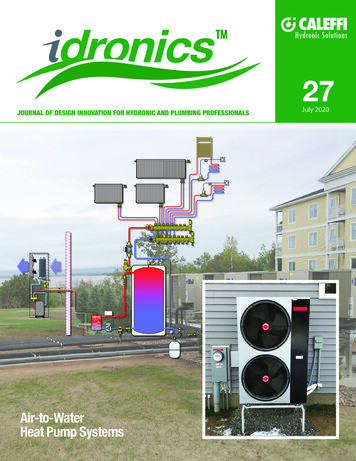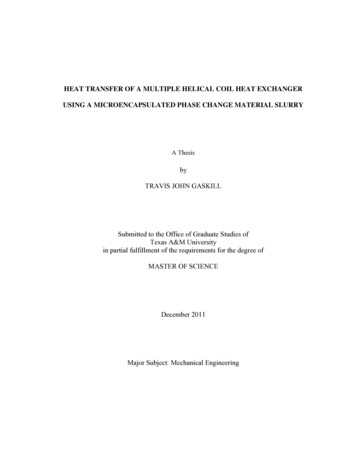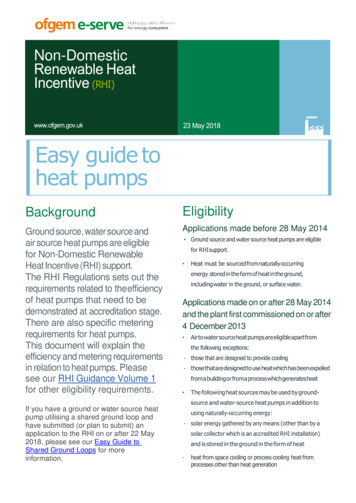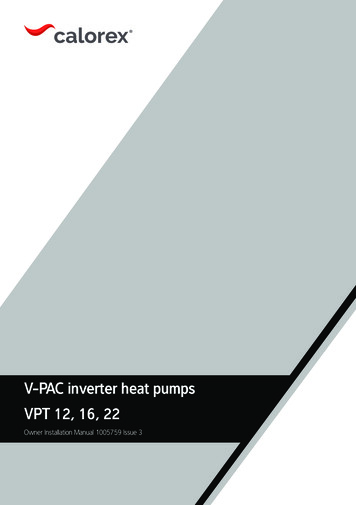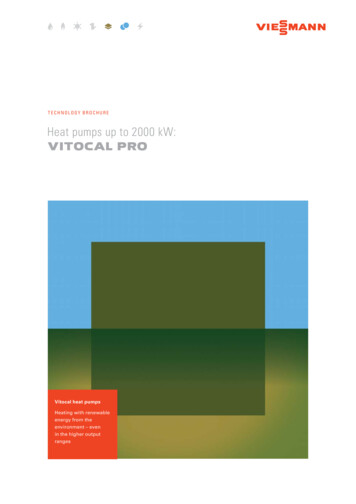
Transcription
Rolling out heat pumpsBarriers and how to overcome themOctober 20211
ROLLING OUT HEAT PUMPS.BARRIERS AND HOW TO OVERCOME THEM.1. Key messages The climate urgency underlined in the 2021 climate change assessment of IPCC1, the EU 2030 targetsand EU climate neutrality by 2050 require unprecedented speed for decarbonizing the economy, including heating, meaning indoor comfort and access to hot water. The fit for 552 package represents a unique opportunity to set the right conditions for acceleratingthe replacement of the old and inefficient heating stock with more efficient, renewable-energy basedheating solutions, such as heat pumps technologies. It is clear that heat pump technologies will play a key role in the pathway towards EU climate neutralityin 2050 and to achieving economy-wide emission reductions of at least 55% 2030 in the EU, as theyare among the most efficient heating solutions, and can significantly contribute to the decarbonisationof buildings; as a result, the market share of heat pump technologies will have to grow significantly. The decarbonization of heating and the heat pump ramp-up must be compatible with the transitionof the overall energy system and consider social impacts; Electrification of heating is a challenge fora stable and resilient energy system with affordable energy costs. By making use of existing energyinfrastructures, the multi-vector approach will optimise the investments in electricity grids; Besides,the building stock and the financial capabilities of EU citizens are extremely heterogeneous, makingemissions from buildings very hard-to-abate, with high impacts on households - ensuring that nobodyis left behind is key for success; hence a range of heating technologies and energy carriers is needed tosupport decarbonization of heating. Furthermore, there are additional challenges to the uptake of heat pump technologies, which will haveto be overcome to support the roll out of heat pumps, these include challenges in the supply chain,standards/legislation and technology.The European heating industry proposes some solutions and recommendations to overcome thesechallenges, such asClose collaborations with grid operators to ensure in-sync development on the product andthe grid side;EU-funding geared towards financing national subsidy and scrappage schemes as well as supporting investments for the uptake of efficient heating, including as heat pump technologies;Ensuring integration of a training on heat pump technologies in programs of educational systems from early on to increase the number of upskilled installers;Innovative solutions to minimize the physical constraints in installing heat pump technologiesand reducing their sound.1. -working-group-i/2. the revisions and initiatives linked to the European Green Deal climate actions and in particular the climate target plan's 55 %3. A multi-vector approach will ensure that the electricity grid does not need to be dimensioned to meet the heat demand during the ‘Kalte Dunkelflaute’, i.e. when the heat demand is high (cold days)and renewable electricity production is low (sunless, windless days)2
2. ContextHeating serves an essential human need. Heat, meaning indoor comfort and access to hot water, supportsthe health and well-being of people, whether they are at home or at their workplace. Putting people at thecentre of their innovation, the members of the European Heating Industry (EHI) are leading the energytransition in the heating sector. EHI members provide affordable, smart and efficient solutions to pave theway to decarbonised buildings in 2050. In doing so, they foster jobs in the European Union (EU), economiccompetitiveness and reduce energy system costs.This paper focusses on hydronic appliances using heat pumps principles, hereafter referred to as heatpumps technologies.Hydronic heating systems in a broad sense are installed in almost 130 million buildings across the EU4, thismakes them the most popular heating system in the EU. Hydronic heat pump technologies use hydronicheat emitters, such as existing radiators, but also convectors and surface heating (floor, ceiling, or walls) toheat buildings and can also be used for cooling and domestic hot water production.With products using heat pump principles we refer to electric and thermally driven heat pumps and heatpumps combined with a boiler, in which case they are referred to as hybrid heat pumps; extracting heatfrom different sources, i.e. from outdoor air, a ground source, a water source or from waste heat. Eachtype and heat source has its own characteristics, so that the choice of one of the aforementioned productsdepends largely on the local environment and the building features. A detailed list of these characteristics,advantages and drawbacks for each type and heat source is to be found in Annex A.Heat pump technologies represented 4 % of the installed stock in the 27 Member States of the EU (EU27)in 20195.FIGURE 1 - Thermally driven heat pumps in commercial and residential areas.4. EU27 UK5. EHI market data 20193
3. The role of heat pump technologies in today’s climatepolicy context and building decarbonisationThe building sector accounts for 40% of the energy consumption6 (and 36 % of the greenhouse gas emissions) in the EU, with heating representing the largest share of energy consumed. Indeed, in residentialbuildings, space and water heating account for 78%7 of the final energy consumed and in industrial buildings, space and process heating account for 71%8 of the final energy consumed. As such, in order to reachthe European Green Deal’s ambition to reduce greenhouse gas emissions by 55% by 2030 in comparisonto 1990 and be climate-neutral by 2050, it is clear that the heating sector will sharply have to reduce theirenergy consumption and increase their use of decarbonized fuels in the next decades. The fit for 55 package represents a unique opportunity to set the right conditions and accelerate the replacement of the oldand inefficient heating stock with more efficient, renewable-energy based heating solutions.Today, around 61 million of the installed heating appliances in the EU are still energy inefficient. As such todecarbonise buildings and heating, the replacement of the installed old and inefficient heating appliancesalongside the improvement of the thermal insulation of the building envelope will be key. It is importantto note that the renovation of space heating and the domestic hot water systems appear overall to bethe most efficient in comparison the building’s insulation (with an average saving per dwelling 2 to 3 timeshigher)9.Heat pump technologies are among the most efficient heating solutions and can be installed in most building types.This makes them an attractive solution for the decarbonisation of buildings and heating. However,there will be no one-size-fits-all solution to decarbonise buildings and heating. This is because buildings aredifferent across the EU, as are heating needs, due to different climates, purpose of use, energy infrastructure, availability of renewable energy resources at local level, individual preferences of the consumer orinstallers for use and economic resources. Hence, the optimal choice of space and water heating systemwill depend on specific local circumstances such as the availability of local renewable sources, the availability and feasibility of the energy infrastructures, the building’s properties, technical building systems and theirlink with the energy system, national energy (pricing) policies. As such, heat pump technologies will be akey part of the solution but will not be the only solution.Nonetheless, it is expected that themarket share of heat pump will steeply grow in the path towards 205010,11.Indeed, the EU scenarios towards2050, foresee that the share of electrification of space heating in residentialbuildings would increase from around4% in 2015 to around 12% in 2030and around maximum 34% in 2050; inthe services sector this would be fromaround 12% in 2015 to around 29%in 2030 and around maximum 51% in205012. Such a quick roll out of heatpumps will present some challenges.FIGURE 2 - A hybrid heat pump.6. Communication from the Commission to the European Parliament, the Council, the European Economic and Social Committee and the Committee of the Regions - a renovation wave for Europe greening our buildings, creating jobs, improving lives. Brussels, 14.10.2020, com(2020) 662 final. (Renovation wave).7. Source: Eurostat - Share of fuels in final energy consumption in the residential sector by type of end-use, 20188. Source: cy/heating-and-cooling en9. La rénovation énergétique des logements : bilan des travaux et des aides entre 2016 et 2019 Données et études statistiques (developpement-durable.gouv.fr)10. In-depth analysis in support of the Commission Communication Com(2018) 773 - A Clean Planet for all, A European long-term strategic vision for a prosperous, modern, competitive and climateneutral economy (In-depth analysis), figure 43, scenarios TECH1.5 and LIFE1.511. Commission staff working document impact assessment accompanying the document communication from the Commission to the European Parliament, the Council, the European Economic andSocial Committee and the Committee of the Regions stepping up europe’s 2030 climate ambition investing in a climate-neutral future for the benefit of our people (Impact assessment for the 2030climate target plan), derived from figure 55 and 56 in comparison to figure 42 of the in depth analysis.12. In case all heating would be electrified by means of electric heat pumps based on the current electricity system, the total energy consumption would increase with about the total final consumptionof electricity in France in 2018 (c.a. 450 TWh). Source: Decarbonising the heating sector, JRC technical report 2019, Figure 37, scenario E100All versus BSL .4
4. Rolling out heat pumps: challenges, solutions andrecommendationsOvercoming financial challengesAccording to the review study for the Ecodesign regulation for space heater13, heat pump technologies arethe most efficient hydronic heating technology on the market today.However, the upfront cost of heat pump technologies can make them economically unattractive for manyconsumers.This is because heat pump technologies are still at least 3 times more expensive than condensing gas boilers in terms of EU average purchase price8.In addition, there currently is a gap between electricity and gas prices. As an example, in the second half of2020 in the EU, the average electricity price was 0.2134 EUR/kWh, in contrast the average gas price was0.0698 EUR/kWh.This price difference largely reflects the Member States’ political decision. Indeed, energypolicy is a competence shared between the EU and its Members, but Member States are responsible fordetermining the structure of their mix and retain broad powers in terms of taxation of energy carriersand fuels. It is expected that the ETS will have an influence on the level of the energy prices in the future,making heat pump technologies more financially attractive for consumers compared to less energy-efficient appliances.In the replacement market, these effects play a higher role than in the new built market. In the new builtsector, the cost over the complete lifetime of heat pump technologies are not higher than alternativesolutions, giving heat pump technologies an edge over competing solutions. As such, especially in the replacement market a lower purchase price and smaller price gap between electricity and gas prices wouldmake heat pump technologies more beneficial.At present, financial incentives or regulatory interventions can help in making the purchase and use ofa heat pump technology more attractive and affordable. In addition to the above, policies that rewarddemand side response - meaning the fact that heat pumps can react to signals from the grid, while stilldelivering heat (e.g. by means of a heat storage system) - can reduce the pressure on the electricity gridvia load shedding during peaks of demand.National scrappage schemes targeting the replacement of old and inefficient heating systems, by taking intoaccount the specificity of building types in each country, are also a good way to support households in thepurchase of a heat pumps.They can be progressive and dedicate higher funding to low and middle-incomehouseholds, helping fight and alleviate energy poverty.In Germany, the subsidyprogram BEG supports theinvestment in heat pumps. Further, in individual buildings, thegrid operator can apply lowerelectricity fees if he is entitledto turn off the product usingthe heat pump technology toa maximum 2 hours for threetimes a day during peak demand in the grid. The discountawarded by the operator caneven reduce the variable costof heating up to 20%14.To finance these national schemes, several funding options atEU-level are possible. With the flagship “renovate” and a minimumof 37% for climate investments and reforms, the Recovery and Resilience Facility is a great opportunity to support subsidy schemesfor heat pump technologies and scrappage schemes. Further funding options at EU-level to support the investment and uptake ofheat pump technologies include InvestEU, the European InvestmentBank funding with its new energy lending policy, and the EU bulkprocurement programme, targeting the upgrade of heating systemsin public buildings. The sale of EU Emission trading system (ETS)15certificates can also provide Member States with the necessaryfunds to support the roll-out of heat pumps. On the private side,taxonomy will play a central role in channelling investments towardsthe projects supporting decarbonization. Therefore, it is crucial thatall heat pump technologies are recognized as “sustainable activity”in this framework in order to attract private funding.13. Space and combination heaters, ecodesign and energy labelling review study (Review study), task 514. Report “Good heating practices from Denmark and Germany”(2018) Forum energii15. https://ec.europa.eu/clima/policies/ets en5
Overcoming challenges in the supply chainReinforcing the electricity gridTo be able to meet the incremental heating demand, but also to allow the planned growth of e-mobilityand to reduce Europe’s dependency on energy imports from outside the EU, it is clear that the electricity grid will need to be reinforced as acknowledged by grid operators16.Several projects are ongoing to develop a future proof, smart, secure and more resilient energy systemready to take on the 2050 challenges17. In addition, by making use of existing energy infrastructures, themulti-vector approach18 will optimise the investments in the electricity grid. Additionally, to ensure thatthe roll out of electric heat pumps and the electricity grid go hand in hand, electricity transmission systemoperators, distributions system operators and smart grid operators will need to cooperate closely and tapinto all sorts of potential flexibility sources, including heat pumps themselves but also other technologies(e.g. electric storage water heaters). It is our aim to set up a close collaboration with these actors to ensurethat we work towards a common goal.Decarbonising the gas gridThe use of the existing gas grids for the distribution of decarbonised gases such as bio-methane, e-methane or green hydrogen will allow for the optimisation of the investments in the electricity grid.Gas driven heat pumps and hybrid heat pumps on the market today can already work with 100% bio-methane. In addition, the industry is developing products that can function with blends of hydrogen19 and purehydrogen or products that can be converted to work with pure hydrogen. As such, the heating industrywill have products available that are compatible with a decarbonised gas grid.Expanding the network of installers capable of working with heat pump technologiesInstalling a heating system requires skills, training and a good understanding of the overall heating systemneeds. In Europe, the Renewable Energy Directive20 (RED) requires installers to have a specific certificationin order to install heat pump technologies; also current version of the F-gas Regulation21 requires naturalpersons who install, service, repair, decommission split heat pump technologies with hydrofluorocarbons(HFCs), do leak checks or reclaim HFCs to be certified.Therefore, installers of heat pump technologies andother experts need to be trained specifically, e.g. in relation to refrigerants and dimensioning of the system,in order to handle heat pump technologies safely, ensure their optimal performance and prevent emissions.However, this ability to work on heat pump technologies with synthetic and natural refrigerants will need tobe extended to the current heating installer network, to be able to comply with the expected deploymentof heat pump technologies throughout Europe. Currently, skilled labour is relatively low in some countries.In Germany and in Poland, only 10% of installers are qualifiedto work with heat pump technologies. Similarly, in the UK, thereare over 129.000 registered ‘Gas Safe’ installers but only 1921registered installers of heat pump technologies.In France already 25% of the installers are qualified to workwith heat pump technologies and it is estimated that in the nextten years, 5000 jobs in the installation of new heat pumps will becreated.The roll out of heat pump technologies in the context of theGreen Deal should translate intoa need for more qualified installers and create significant job opportunities.Therefore, policies should begeared towards training andupskilling enough installers tohandle the Renovation Wave16. Distribution system operators have estimated that between 375 and 425 billion euros will have to be invested in power distribution grids alone in the decade 2020-2030. EURELECTRIC, E-DSOMonitor Deloitte, Connecting the dots: Distribution grid investment to power the energy transition (January 2021), . Some examples of EU Horizon 2020 funded projects: OneNet, BD4NRG, Interrface, CoordiNET, Crossbow, Eusysflex18. A multi-vector approach will ensure that the electricity grid does not need to be dimensioned to meet the heat demand during the ‘Kalte Dunkelflaute’, i.e. when the heat demand is high (cold days)and renewable electricity production is low (sunless, windless days).19. A variable share of hydrogen up to 20 % by volume20. Directive 2018/2001/EU21. Regulation (EU) No 517/20146
FIGURE 3 - More and upskilled installers are needed for heat pump growth in the market.and support the penetration of heat pumptechnologies.The industry is committed to bepart of this process.In France, the national heating association Uniclima serves on the Board of the organism which isaccredited to deliver certification to installers forrenewable installations, including heat pump technologies. Furthermore, the association supportsactively the recognition of the training delivered bymanufacturers in the scheme.Installer capacity GermanyIn addition, to facilitate the work of installers, manufacturers have been developing state-of-the-art connectivity technology, from factory mounted integratedman-machine interface, allowing easy and remote commissioning of units, up to online and voice control viaapplications, enhancing the end user efficient use andmonitoring of heat pump technologies. These functionsshould be included in the training programs.Finally, to ensure that young installers in training get acquainted with heat pump technologies from early on,educational systems should integrate training on heatpump technologies in their programs.Increasing periodic inspections of heat pump technologiesFIGURE 4 - Predictions of needed installers of heating appliancesby 2030 in Germany, based on two higher electrification scenarios:- Scenario 1 (lower line, in blue): to reach 3 million installed electric heat pumps requires 25% more installers than 2020 level(current installed stock of heat pumps in Germany: around 1 million);- Scenario 2 (top line, in green): to reach 6 million installed electric heat pumps requires 100% more installers than 2020 level”.(estimate Bosch TT)It was shown e.g. by Ademe that performance deterioration can occur in the absence of maintenance.Furthermore, in the absence of regular checks, malfunctions cannot be diagnosed early-on, potentiallyleading to energy losses and increasing the risk for consumers of having to replace their heat pump earlierthan expected.7
Measures facilitating appropriate maintenance include hydraulics, cleaning, doublecheck of control parameters and provide the user with advice for good use, possible improvements and possible need for replacement. Their consistent application helps to ensure that the heat pump stock remains efficient and robust.In practice, regular checks, implemented e.g. in France for heat output above 4 kW, or appropriate buildingautomation and control functionalities support preventive maintenance and optimized performance ofheat pump systems - as required under Articles 8 and 14 of the EPBD. New energy labelling for spaceand water heaters should support preventive maintenance functionalities, to facilitate national schemesimplementing the EPBD.FIGURE 5 - An example of an air to water heat pump.Overcoming technological challengesReducing constraints due to the physical characteristics of heat pump technologiesToday, products based on the heat pump technology exist in different capacities to fit in all types of building.However, in some cases, these appliances can take up more space than a conventional heat generator suchas a boiler, posing additional challenges for its installation.Indeed, part of the heat pump or the complete unit, and, or pipework in case of a ground source heatpump, needs to be installed outside (or in a non-heated area inside the building). For some buildings, suchan installation might not be possible due to space limitations.Our industry is currently developing solutions to tackle this problem. For instance, in the Netherlands, asignificant number of installations are with the outdoor unit placed on the rooftop. In the case of groundsource heat pumps and depending on the drilling possibilities, the pipework can be laid vertically in boreholes rather than horizontally in trenches to adapt to limited garden space22.Moreover, great achievements have been made by component integration. All necessary installation devices (expansion vessel, pumps, safety valves, etc.) are included in the casing and do not need additionalspace. Further improvements are possible thanks to advanced system designs which make buffer tanksobsolete.Reducing sound of heat pump technologiesWhen installing heat pump technologies, special acoustic parameters and often special acoustic planning22. ce-do-you-need-for-a-heat-pump/8
6.7.FIGURE 6 & 7 - Compared to horizontally laid pipeworks, vertically laid pipeworks require less garden space.are needed at the place of installation. Indeed, the compressor of electrical heat pumps and some thermally driven heat pumps generates sound. In air to water heat pumps, the fan in the outdoor unit addsto the noise. This can be problematic in densely populated residential areas, where sound emissions aresometimes the subject of complaints.In recent years, manufacturers of heat pumptechnologies made huge progress in delivering solutions to reduce the sound of the heatpump’s outdoor unit without affecting the energy efficiency of the appliance. Solutions includeadding additional insulation material in the outdoor unit to reduce the sound, encapsulation ofthe compressor, multistage decoupling as well asdedicated outdoor units with new fan designsthat ensure lower sound emissions.Furthermore the heat pump technologies areoptimized in terms of psychoacoustic i.e. noises that are perceived as especially annoying arereduced or completely banned. Finally, since theoptical appearance also has an influence onnoise perception, fans are covered and not visible anymore.These innovations lead to more freedom in thechoice of location for appliance, as the soundemission will not be detectable at places of interest, e.g. close to the neighbour’s windows.FIGURE 8 - Hidden fans reduce the perception of the sound.9
5. Policy recommendationsThe “Fit for 55” package represents a unique opportunity to set the right conditions for accelerating thereplacement of the old and inefficient heating stock with more efficient, renewable-energy based heatingsolutions, such as heat pump technologies.To accelerate the replacement of old and inefficient installed heating appliances, including by a growingshare of products based on the heat pump technology, the EHI recommends to: Further raise awareness by (re)introducing:regular checks of heating appliances below 70 kW in the EPBD, unless appliances have self-predicting maintenance functionalities;an EU wide energy label for the installed stock, to inform consumers about the (in)efficiencyof their installed appliances and allow them to easily compare them with more performantsolutions available on the market (such initiatives have already been implemented in someMember States, like Germany, and are currently being promoted by the H2020 project HARP);scrappage schemes in the EPBD and/or other relevant EU legislation to support consumersfinancially in purchasing a new appliance (as already implemented in e.g. Germany, Italy);an EU energy label for new appliances that is useful for end-users and investors in their purchasing decision, incentivising faster and deeper modernisation of their heating appliancesaccording to their individual needs in support of the renovation wave and implementation ofthe Energy Performance of Buildings Directive. Support the replacement of old and inefficient heaters through the introduction of an annual replacement target of at least 6%/year in the EPBD, to be reflected across all relevant EU legislation; In case minimum energy performance standards for buildings (MEPS) were included in the EPBD, ensure they address the heating dimension of buildings and support/require the replacement of old andinefficient heating systems; Make sure that any new definition or requirement to be set for deep and staged-deep renovationsincludes and prioritises actions on heating systems, notably the installation of efficient technologies andthe progressive switch to renewable and decarbonised energy sources.In addition, to support the roll out of heat pump technologies in the coming years and building on theproposals made by the European Commission in the recently published package, the EHI believes that theco-legislators should: Ensure the proposed EU renewable energy target of 40% by 2030 in the RED as well as sectoraltargets for renewables in buildings and in heating and cooling are coupled with adequate measures tosupport the uptake of efficient and renewable-based heating products; Keep the successful calculation of renewable energy (According to the RED, Annex VII) that can becaptured via heat pump technologies and considered for renewable energy target and ensure that itis coherently applied in each Member State; Promote all types of heat pump technologies by explicitly acknowledging the different types of heatpump technologies in the different policies; allowing for the use of all renewable compatible appliances, including hybrid- and thermally-driven heat pumps, to achieve Member States’ energy savingsobligations; creating a product category for hybrids and adequate requirements for promoting all heatpump technologies in ecodesign and energy labelling; and granting Member States enough flexibility indetermining the options to achieve minimum levels of renewables in buildings.10
Ensure that a diversity of refrigerants can be used in the different innovative heat pump applicationsin view of the ongoing review of the F-gas regulation and the per- and polyfluoroalkyl substances(PFAS) restriction in regulation on registration, evaluation, authorisation and restriction of chemicals24(REACH); Support the proposal to extend the EU Emission Trading System (ETS) to buildings, to accelerate thereplacement of old and inefficient heating appliances with efficient and renewable compatible ones,including heat pumps; Within the EU ETS, earmark revenues to finance the replacement of old andinefficient heaters with efficient and renewable-compatible ones – including all kind of heat pumps.This would cut CO2 emissions, promote renewables and energy efficiency, which keeps under controlenergy expenses for households. In this sense, both the Modernisation and the Social Climate Fundshould focus on the replacement of old and inefficient heaters; Promote low carbon and renewable energy sources via the energy taxation Directive;Review of the primary energy factor (PEF) in line with the schedule in the energy efficiency directive25(EED);Promote demand-side flexibility via smart grid enabled appliances, meaning appliances that can reactto signals from third-party such as electric grid operators.Finally, as financing will be a key element for the uptake of heat pumps, EHI recommends to: Make heat pump technologies more financially attractive for households by financing national subsidyand scrappage schemes via the Recovery and Resilience Facility; Support the investment in heat pump technologies via InvestEU and the European Investment Bankfunding;Support their uptake in public buildings with the EU bulk procurement programme.FIGURE 10 - Working principle of a hybrid heat pump.FIGURE 11 - Operating principle of an electric heat pump.FIGURE 9 - Electric air-to-water heat pump.24. Regulation (EC) No 1907/200625. Directive 2012/27/EU amen
However, the upfront cost of heat pump technologies can make them economically unattractive for many consumers. This is because heat pump technologies are still at least 3 times more expensive than condens-ing gas boilers in terms of EU average purchase price8. In addition, there currently is a gap between electricity and gas prices.





